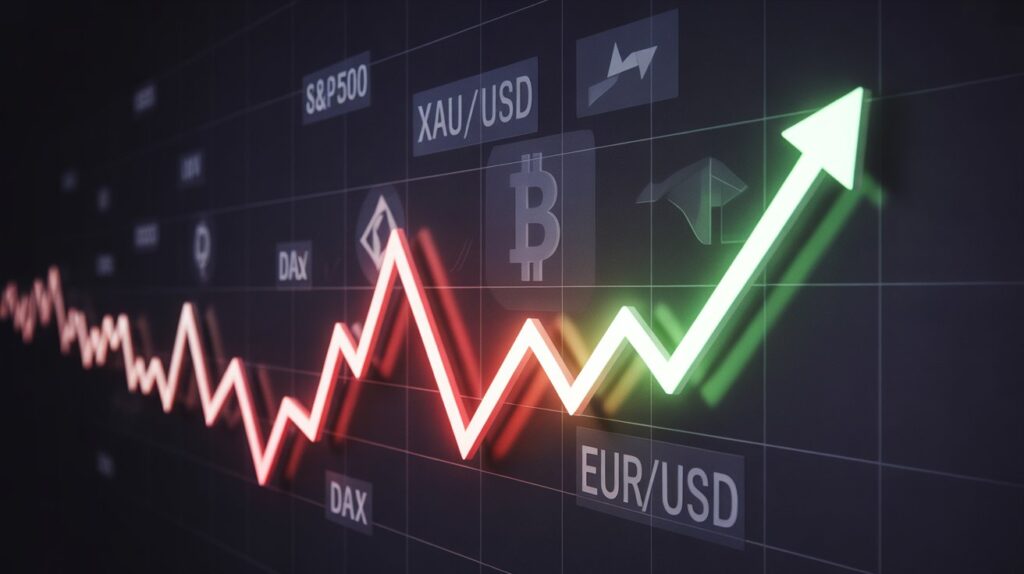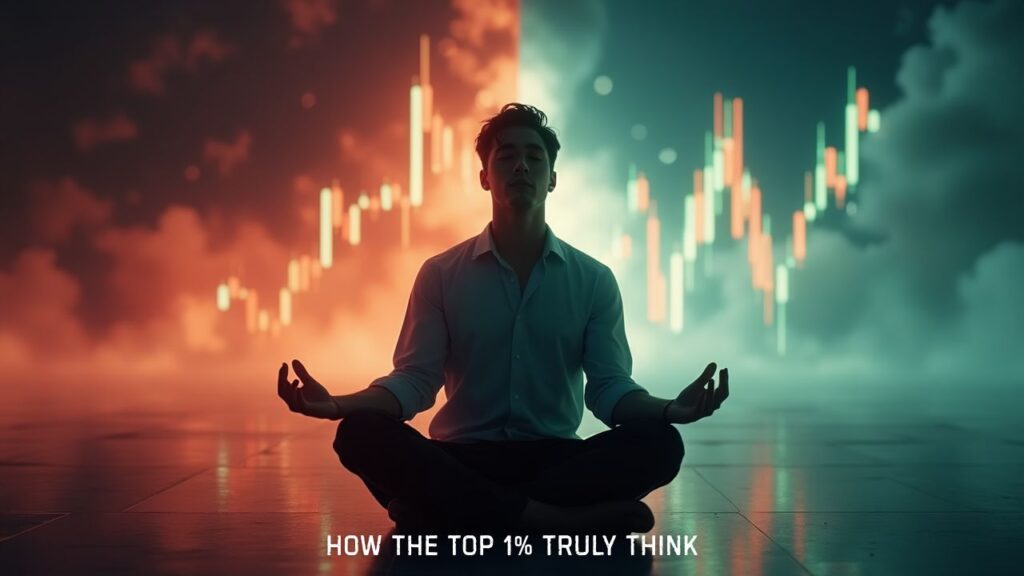Forex trading isn’t just about chart patterns or candlesticks. It’s about understanding the psychology behind decisions, the macroeconomic forces shaping currencies, and disciplined risk management. In this article, I’ll show you how to trade successfully by mastering the mind, not memorizing patterns. This approach answers the question: how to trade forex without charts while highlighting why many traders fail in forex.
Let Me Tell You a Story
When I was 19, I believed I had discovered the secret to the markets. It wasn’t insider news or deep macroeconomic knowledge. It was chart patterns. I remember proudly telling my dad (who didn’t know much about trading) that I could predict where the euro was going just by looking at candlesticks.
“So you’re telling me,” he said, raising an eyebrow, “that a global currency moved because of a triangle?”
I didn’t know it then, but that question would haunt, and eventually liberate me.
For many traders, the seduction of charts is irresistible. They’re clean. They’re visual. They give us a sense of control in a world where we have none. But forex trading psychology teaches that the real market moves are invisible, messy, and often unpredictable. It’s about psychology, economics, and strategy.
“Charts can show you the path but they can’t tell you the story. The real lesson is in the why, not the line.”
Here’s what trading is really about.
The Myth of Technical Perfection
Charts offer an illusion of precision. Support, resistance, Fibonacci levels, head and shoulders: they all promise clarity. But markets aren’t math problems. They are puzzles with missing pieces.
Charts can guide… yes, but they cannot predict. Because what moves markets isn’t always a breakout pattern. It’s the decision of a central bank in Tokyo, a surprise inflation print in Berlin, or a geopolitical event no one saw coming.
If trading was about chart mastery, every software engineer with a chart bot would be a millionaire. They’re not. And here’s why.
Economics Trumps Aesthetics
Currencies move because countries change. When inflation rises, central banks raise interest rates. When economies stall, they cut them. This ebb and flow creates trends not triangles.
Understanding forex means understanding macroeconomics. Economic indicators like GDP, unemployment, CPI, and PMI aren’t background noise, they’re the soundtrack to currency movement.
Interest-rate differentials fuel the carry trade, where traders borrow in low-rate currencies and invest in high-rate ones. Over time, this builds momentum. Geopolitical tensions (think Brexit or Ukraine) can send a currency into a nosedive, regardless of what any chart says.
Imagine trying to drive by only looking in the rearview mirror. That’s what trading purely on charts is like.
Central Banks: The Real Market Movers
Many traders act like gamblers watching roulette wheels. But the real game is happening in central bank boardrooms.
The Federal Reserve, European Central Bank, Bank of Japan and others don’t follow your trendlines. They set the rules: interest rates, quantitative easing, forward guidance. This is what shapes the forex landscape.
Markets don’t wait for rate changes, they react to the expectation of change. That’s why speeches, meeting minutes, and subtle shifts in tone can cause more volatility than actual decisions.
If you’re not listening to central banks, you’re trading blind.
Why Emotional Discipline Outweighs Chart Patterns
You can learn chart patterns in a week. But mastering your emotions? That takes years.
Forex trading is a psychological war. The enemy isn’t the market, it’s your own fear and greed. When trades go against you, your brain screams: “Double down!” When you’re up, it whispers: “Take profit now!”
Discipline is the trader’s sword. Not strategy. Not software. Discipline.
“Discipline is the sword. Charts are just the paper it’s written on.”
You don’t need to be right all the time, you need to be consistent. You don’t need the perfect entry, you need the perfect mindset. You don’t need to control the market, you need to control yourself.
The best traders are emotionally indifferent to wins and losses. They don’t chase. They don’t panic. They execute.
Risk Management: The Quiet King
Most traders spend 90% of their time figuring out where to enter a trade. The best traders spend 90% of their time figuring out how to manage what happens next.
In other words: position sizing, stop-losses, and risk-reward ratios, these become your survival kit. As Investopedia explains, you must accept the potential loss upfront before you even take the trade.
A consistent 1:2 risk-reward setup makes profitability a numbers game, not a prediction contest. You can lose 60% of the time and still make money. Let that sink in.
Trading Is a Mental Marathon
Trading isn’t sprinting, it’s endurance. It’s 20% strategy and 80% psychology. This isn’t just a saying, it’s the cold truth.
You can have the best model, the cleanest charts, the most powerful software and still blow up because you lacked patience, over-leveraged, or panicked at the wrong moment.
Great traders reflect. They keep journals. They review trades. They ask: “What did I feel when I entered this trade? Was it greed? Ego? Impatience?”
That post-trade analysis becomes the real education. Not YouTube tutorials. Not Instagram gurus. Your own mind is the final frontier.
Read more: The Role of Journaling in Trading Psychology
Sentiment: Reading the Room
Charts don’t reflect sentiment until it’s too late. Currency markets are driven by mood swings: fear, optimism, and uncertainty.
- A rumor about an interest-rate hike? Market moves.
- Unexpected data release? Market moves.
- Sudden drop in liquidity during the Asian session? Market moves.
Reading sentiment means:
- Knowing when rumors matter more than facts
- Understanding correlations between assets (oil & CAD, gold & AUD)
- Recognizing when liquidity is drying up, leading to violent swings
Forex isn’t about predicting price, it’s about understanding people.
See also: How to Stay Calm During Drawdowns
Why Traders Fail: It’s Not the Charts
Here’s a clear breakdown:
| Cause | Percentage |
|---|---|
| Poor risk management | 40% |
| Emotional discipline | 30% |
| Lack of macro awareness | 15% |
| Strategy inconsistency | 10% |
| Chart misinterpretation | 5% |
When you see it like that, charts become trivial. The real edge comes from managing yourself and understanding markets at a deeper level.
Strategy Is a Framework, Not a Formula
People want a holy grail strategy. The truth is: the best traders don’t follow formulas. They follow frameworks. A framework adapts. It evolves with the market.
Your plan should include:
- Macro awareness
- Psychological boundaries
- Tactical flexibility
- Rules for trading during news events
- Emotional checkpoints
- Maximum loss per day/week/month
You need a strategy for when you lose, not just when you win.
The Lie of the Lone Wolf
Movies portray traders as lone geniuses arguing with screens. Real success in forex comes from community and collaboration.
- Join forums. Share insights.
- Read economists. Follow central bank reports.
- Learn from mentors. Debate ideas.
No great trader made it alone. Not Soros. Not Druck. Trading is lonely enough, don’t make it harder by isolating yourself.
A Step-by-Step Guide: How to Trade Forex Without Obsessing Over Charts
- Review macro trends daily: check GDP, CPI, PMI updates.
- Track emotions in a trading journal: note fear, greed, impatience.
- Set max loss per trade/day/week: protect your capital.
- Use proper position sizing and risk-reward ratios: survival first.
- Reflect on every trade weekly: not just results, but mindset.
What Trading Is Really About
If you strip everything away, trading is about:
- Making decisions under uncertainty
- Managing risk with discipline
- Understanding human behavior
- Constant self-reflection
Charts are just the surface, they’re the language, not the meaning. The real message lies beneath: macro trends, central bank moves, psychological strength, and strategic clarity.
So next time you’re tempted to stare at a chart for hours, remember: the world moves currencies, not candlesticks.
Final Thought: The Mirror Test
Stand in front of a mirror and ask:
- Do I have a plan?
- Do I know why this currency is moving?
- Am I trading to win, or just to feel in control?
If you can answer those honestly, you’re on the path to real trading mastery.
Trading isn’t about lines and levels. It’s about how you think, how you feel, and how you respond.
That’s what separates the chart-watchers from the real traders. That’s what forex trading psychology is really about.
Newsletter Signup
Ready to Trade with Clarity, Not Chaos?
Join The Reborn Trader newsletter for weekly deep insights on trading psychology, mindset mastery, and high-performance strategies.
Subscribe Now, Elevate how you think before you trade.

FAQs
What drives forex markets beyond technical indicators?
While charts help visualize price movement, forex is ultimately driven by macroeconomic forces, like central bank policies, inflation rates, employment data, and geopolitical shifts that influence global currency values.
How important is interest rate divergence and the carry trade in forex?
Extremely important. Traders often buy currencies from countries with high interest rates and sell those from countries with low rates to profit from the interest differential this is the carry trade. Interest rate divergence is a key driver of long-term trends.
What is the best forex trading platform for beginners?
Popular beginner-friendly platforms include MetaTrader 4 (MT4), MetaTrader 5 (MT5), TradingView, and cTrader. Look for platforms that offer demo accounts, user-friendly interfaces, and access to macroeconomic data and sentiment indicators, not just charts.
How can beginners start trading forex safely?
Start with a demo account. Learn the basics of macroeconomics, risk management, and emotional control. Avoid high leverage. Focus on building a consistent process before ever risking real capital.
For a structured, beginner-friendly education, check out the School of Pipsology by BabyPips.
What is currency market trading, and how is it different from stock trading?
Currency trading (forex) involves buying and selling currency pairs like EUR/USD or GBPUSD. Unlike stock trading, forex operates 24 hours a day, is heavily influenced by global economics, and typically involves more leverage and volatility.
What psychological traits are essential for forex trading success?
Discipline, emotional resilience, patience, and self-awareness are essential. Great traders spend more time managing themselves than the market.
How can I create a trading plan that actually works?
A strong plan includes a macroeconomic bias, risk rules (like1:2 reward-to-risk), stop-loss and position sizing strategies, journaling routines, and guidelines for handling emotional triggers. The best plans evolve with your experience.
What is rollover in forex trading and why does it matter?
Rollover is the interest earned or paid for holding a currency pair overnight. It’s based on the interest rate differential between the two currencies and can impact long-term profitability, especially for swing or position traders.




